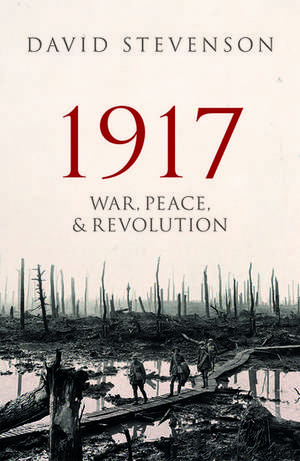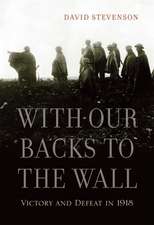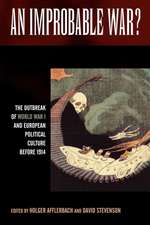1917: War, Peace, and Revolution
Autor David Stevensonen Limba Engleză Hardback – 12 oct 2017
| Toate formatele și edițiile | Preț | Express |
|---|---|---|
| Paperback (1) | 96.62 lei 10-16 zile | +42.83 lei 7-13 zile |
| OUP OXFORD – 25 iul 2019 | 96.62 lei 10-16 zile | +42.83 lei 7-13 zile |
| Hardback (1) | 197.40 lei 10-16 zile | |
| OUP OXFORD – 12 oct 2017 | 197.40 lei 10-16 zile |
Preț: 197.40 lei
Preț vechi: 235.94 lei
-16% Nou
Puncte Express: 296
Preț estimativ în valută:
37.77€ • 39.52$ • 31.38£
37.77€ • 39.52$ • 31.38£
Carte disponibilă
Livrare economică 01-07 martie
Preluare comenzi: 021 569.72.76
Specificații
ISBN-13: 9780198702382
ISBN-10: 0198702388
Pagini: 528
Ilustrații: 21 black and white illustrations and 9 maps
Dimensiuni: 168 x 242 x 45 mm
Greutate: 0.82 kg
Editura: OUP OXFORD
Colecția OUP Oxford
Locul publicării:Oxford, United Kingdom
ISBN-10: 0198702388
Pagini: 528
Ilustrații: 21 black and white illustrations and 9 maps
Dimensiuni: 168 x 242 x 45 mm
Greutate: 0.82 kg
Editura: OUP OXFORD
Colecția OUP Oxford
Locul publicării:Oxford, United Kingdom
Recenzii
This is an excellent book. Forget the 'on the one hand this', and 'on the other hand that' typical of most book reviews - just go out and buy yourself a copy.
A welcome addition to the literature that challenges the all-too-safe and pernicious stereotypes of the history of the First World War that unfortunately still dominate popular culture.
1917 will be of great interest to those readers who wish to better understand the broader implications of strategic and diplomatic decisions during the penultimate year of the conflict. It is in that field that Stevenson is an unrivalled master and his comprehensively researched book on 1917 will be welcomed by many.
1917 is a triumph by a masterly historian, and one of the most important books to have been published during the centenary years of the First World War.
1917: War, Peace, and Revolution represents a thoughtful synthesis of relevant secondary literature and published primary and archival sources. Its narrative is enriched by an invaluable bibliography, maps and photographs spread throughout the text, and helpful lists of abbreviations and principal personalities. It is a seminal work that will engage and inform students, scholars, and general readers alike.
David Stevenson's book is a cool and original account of the heat of war in 1917. It surpasses previous studies in terms of its global range and its archival depth. Here is a history of decision-making by the sleepwalkers who kept on their murky path into war three years after its outbreak, and of those few - including Lenin - who found a way out of the slaughterhouse. Stevenson's is history as tragedy, with hubris bringing down those who thought they could master the destructive forces of the Great War.
The European nations had dug themselves by 1917 into a war trap seemingly without exit - this is the starting point of David Stevenson's new book. The events of 1917, war, peace, and revolution, the struggle to get out of the war, get here a thorough reassessment. The book is an example for the combination of competent analysis with a gripping narrative and clear judgement.
A welcome addition to the literature that challenges the all-too-safe and pernicious stereotypes of the history of the First World War that unfortunately still dominate popular culture.
1917 will be of great interest to those readers who wish to better understand the broader implications of strategic and diplomatic decisions during the penultimate year of the conflict. It is in that field that Stevenson is an unrivalled master and his comprehensively researched book on 1917 will be welcomed by many.
1917 is a triumph by a masterly historian, and one of the most important books to have been published during the centenary years of the First World War.
1917: War, Peace, and Revolution represents a thoughtful synthesis of relevant secondary literature and published primary and archival sources. Its narrative is enriched by an invaluable bibliography, maps and photographs spread throughout the text, and helpful lists of abbreviations and principal personalities. It is a seminal work that will engage and inform students, scholars, and general readers alike.
David Stevenson's book is a cool and original account of the heat of war in 1917. It surpasses previous studies in terms of its global range and its archival depth. Here is a history of decision-making by the sleepwalkers who kept on their murky path into war three years after its outbreak, and of those few - including Lenin - who found a way out of the slaughterhouse. Stevenson's is history as tragedy, with hubris bringing down those who thought they could master the destructive forces of the Great War.
The European nations had dug themselves by 1917 into a war trap seemingly without exit - this is the starting point of David Stevenson's new book. The events of 1917, war, peace, and revolution, the struggle to get out of the war, get here a thorough reassessment. The book is an example for the combination of competent analysis with a gripping narrative and clear judgement.
Notă biografică
David Stevenson holds the Stevenson Chair of International History at the London School of Economics & Political Science, where he has twice been Head of Department and teaches and lectures on the history of international relations. He is the author or editor of seven books about the origins, course, and consequences of the First World War. His publications include Armaments and the Coming of War: Europe, 1904-1914 (OUP, 1996), 1914-1918: the History of the First World War (Penguin, 2004), With Our Backs to the Wall: Victory and Defeat in 1918 (Penguin, 2011), and (co-edited with Thomas Mahnken and Joseph Maiolo), Arms Races in International Politics: from the Nineteenth to the Twenty-First Century (OUP, 2016).









